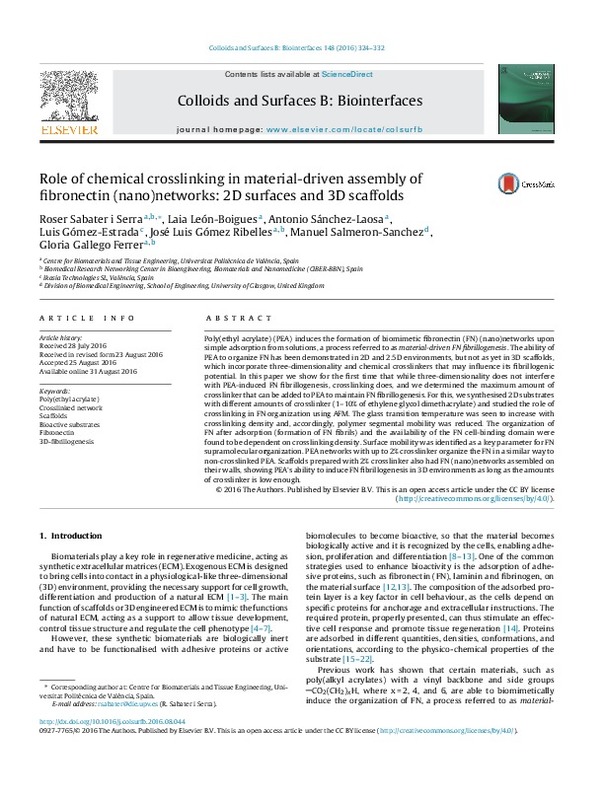JavaScript is disabled for your browser. Some features of this site may not work without it.
Buscar en RiuNet
Listar
Mi cuenta
Estadísticas
Ayuda RiuNet
Admin. UPV
Role of chemical crosslinking in material-driven assembly offibronectin (nano)networks: 2D surfaces and 3D scaffolds
Mostrar el registro sencillo del ítem
Ficheros en el ítem
| dc.contributor.author | Sabater i Serra, Roser
|
es_ES |
| dc.contributor.author | León-Boigues, Laia
|
es_ES |
| dc.contributor.author | Sánchez Laosa, Antonio
|
es_ES |
| dc.contributor.author | Gómez Estrada, Luis
|
es_ES |
| dc.contributor.author | Gómez Ribelles, José Luís
|
es_ES |
| dc.contributor.author | Salmerón Sánchez, Manuel
|
es_ES |
| dc.contributor.author | Gallego-Ferrer, Gloria
|
es_ES |
| dc.date.accessioned | 2017-05-23T14:21:48Z | |
| dc.date.available | 2017-05-23T14:21:48Z | |
| dc.date.issued | 2016-12-01 | |
| dc.identifier.issn | 0927-7765 | |
| dc.identifier.uri | http://hdl.handle.net/10251/81661 | |
| dc.description.abstract | Poly(ethyl acrylate) (PEA) induces the formation of biomimetic fibronectin (FN) (nano)networks uponsimple adsorption from solutions, a process referred to as material-driven FN fibrillogenesis. The ability ofPEA to organize FN has been demonstrated in 2D and 2.5D environments, but not as yet in 3D scaffolds,which incorporate three-dimensionality and chemical crosslinkers that may influence its fibrillogenicpotential. In this paper we show for the first time that while three-dimensionality does not interferewith PEA-induced FN fibrillogenesis, crosslinking does, and we determined the maximum amount ofcrosslinker that can be added to PEA to maintain FN fibrillogenesis. For this, we synthesised 2D substrateswith different amounts of crosslinker (1 10% of ethylene glycol dimethacrylate) and studied the role ofcrosslinking in FN organization using AFM. The glass transition temperature was seen to increase withcrosslinking density and, accordingly, polymer segmental mobility was reduced. The organization ofFN after adsorption (formation of FN fibrils) and the availability of the FN cell-binding domain werefound to be dependent on crosslinking density. Surface mobility was identified as a key parameter for FNsupramolecular organization. PEA networks with up to 2% crosslinker organize the FN in a similar way tonon-crosslinked PEA. Scaffolds prepared with 2% crosslinker also had FN (nano)networks assembled ontheir walls, showing PEA s ability to induce FN fibrillogenesis in 3D environments as long as the amountsof crosslinker is low enough. | es_ES |
| dc.description.sponsorship | M.S.S. acknowledges funding from ERC (HealInSynergy 306990) and the UK MRC (MR/L022710/1). The support from the Ministry of Economy and Competitiveness-Spain (MAT2015-69315-C3-1-R Project) including the FEDER financial support, is gratefully acknowledged. CIBER-BBN is an initiative funded by the VI National R&D&I Plan 2008-2011, Iniciativa Ingenio 2010, Consolider Program. CIBER Actions are financed by the Instituto de Salud Carlos III with assistance from the European Regional Development Fund. We are also grateful to the Electron Microscopy Service of Universitat Politecnica de Valencia for their valuable help. | en_EN |
| dc.language | Inglés | es_ES |
| dc.publisher | Elsevier | es_ES |
| dc.relation.ispartof | Colloids and Surfaces B: Biointerfaces | es_ES |
| dc.rights | Reconocimiento (by) | es_ES |
| dc.subject | Poly(ethyl acrylate) | es_ES |
| dc.subject | Crosslinked network | es_ES |
| dc.subject | Scaffolds | es_ES |
| dc.subject | Bioactive substrates | es_ES |
| dc.subject | Fibronectin | es_ES |
| dc.subject | 3D-fibrillogenesis | es_ES |
| dc.subject | Electron Microscopy Service of the UPV | es_ES |
| dc.subject.classification | INGENIERIA ELECTRICA | es_ES |
| dc.subject.classification | MAQUINAS Y MOTORES TERMICOS | es_ES |
| dc.subject.classification | FISICA APLICADA | es_ES |
| dc.title | Role of chemical crosslinking in material-driven assembly offibronectin (nano)networks: 2D surfaces and 3D scaffolds | es_ES |
| dc.type | Artículo | es_ES |
| dc.identifier.doi | 10.1016/j.colsurfb.2016.08.044 | |
| dc.relation.projectID | info:eu-repo/grantAgreement/EC/FP7/306990/EU/Material-driven Fibronectin Fibrillogenesis to Engineer Synergistic Growth Factor Microenvironments/ | |
| dc.relation.projectID | info:eu-repo/grantAgreement/UKRI//MR%2FL022710%2F1/GB/Synergistic microenvironments for non-union bone defects/ | es_ES |
| dc.relation.projectID | info:eu-repo/grantAgreement/MINECO//MAT2015-69315-C3-1-R/ES/SOPORTES CELULARES BIODEGRADABLES CARGADOS CON IONES BIOACTIVOS PARA REGENERACION MUSCULAR/ | es_ES |
| dc.rights.accessRights | Abierto | es_ES |
| dc.contributor.affiliation | Universitat Politècnica de València. Centro de Biomateriales e Ingeniería Tisular - Centre de Biomaterials i Enginyeria Tissular | es_ES |
| dc.contributor.affiliation | Universitat Politècnica de València. Escuela Técnica Superior de Ingenieros Industriales - Escola Tècnica Superior d'Enginyers Industrials | es_ES |
| dc.contributor.affiliation | Universitat Politècnica de València. Escuela Técnica Superior de Ingeniería del Diseño - Escola Tècnica Superior d'Enginyeria del Disseny | es_ES |
| dc.description.bibliographicCitation | Sabater I Serra, R.; León-Boigues, L.; Sánchez Laosa, A.; Gómez Estrada, L.; Gómez Ribelles, JL.; Salmerón Sánchez, M.; Gallego-Ferrer, G. (2016). Role of chemical crosslinking in material-driven assembly offibronectin (nano)networks: 2D surfaces and 3D scaffolds. Colloids and Surfaces B: Biointerfaces. 148:324-332. https://doi.org/10.1016/j.colsurfb.2016.08.044 | es_ES |
| dc.description.accrualMethod | S | es_ES |
| dc.relation.publisherversion | http://dx.doi.org/10.1016/j.colsurfb.2016.08.044 | es_ES |
| dc.description.upvformatpinicio | 324 | es_ES |
| dc.description.upvformatpfin | 332 | es_ES |
| dc.type.version | info:eu-repo/semantics/publishedVersion | es_ES |
| dc.description.volume | 148 | es_ES |
| dc.relation.senia | 317295 | es_ES |
| dc.identifier.eissn | 1873-4367 | |
| dc.identifier.pmid | 27619185 | en_EN |
| dc.identifier.pmcid | PMC5109969 | en_EN |
| dc.contributor.funder | UK Research and Innovation | es_ES |
| dc.contributor.funder | Ministerio de Economía y Competitividad | es_ES |
| dc.contributor.funder | European Regional Development Fund | es_ES |
| dc.contributor.funder | Instituto de Salud Carlos III | es_ES |
| dc.contributor.funder | Ministerio de Ciencia e Innovación | es_ES |
| dc.contributor.funder | European Commission | es_ES |








